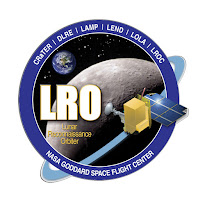NASA - Lunar Reconnaissance Orbiter (LRO) patch.
April 29, 2016
A powerful combination of observations and computer simulations is giving new clues to how the moon got its mysterious "tattoos" -- swirling patterns of light and dark found at over a hundred locations across the lunar surface.
Image above: This is an image of the Reiner Gamma lunar swirl from NASA's Lunar Reconnaissance Orbiter. Image Credits: NASA LRO WAC science team.
"These patterns, called 'lunar swirls,' appear almost painted on the surface of the moon," said John Keller of NASA's Goddard Space Flight Center in Greenbelt, Maryland. "They are unique; we've only seen these features on the moon, and their origin has remained a mystery since their discovery." Keller is project scientist for NASA's Lunar Reconnaissance Orbiter (LRO) mission, which made the observations.
Lunar swirls can be tens of miles across and appear in groups or just as an isolated feature. Previous observations yielded two significant clues about their formation: First, they appear where ancient bits of magnetic field are embedded in the lunar crust (although not every "fossil" magnetic field on the moon has a lunar swirl). Second, the bright areas in the swirls appear to be less weathered than their surroundings. The space environment is harsh; many things can cause material exposed to space to change chemically and darken over time, including impacts from microscopic meteorites and the effects of the solar wind – a million-mile-per-hour stream of electrically conducting gas blown from the surface of the sun.
Those clues led to three prominent theories about how the swirls formed. The swirls and the magnetic fields could both have formed from plumes of material ejected by comet impacts. Alternatively, perhaps when fine dust particles get lofted by micrometeorite impacts, an existing magnetic field over the swirls sorts them according to their susceptibility to magnetism, forming light and dark patterns with different compositions. Finally, since particles in the solar wind (electrons and ions) are electrically charged, they respond to magnetic forces. Perhaps the magnetic field shields the surface from weathering by the solar wind.
In the new research, teams of scientists created computer models that provide new insights into how the magnetic shield hypothesis could work. "The problem with the magnetic shield idea is that the embedded magnetic fields on the moon are very weak – about 300 times weaker than Earth's magnetic field," said Bill Farrell of NASA Goddard. "It's hard to see how they would have the strength to deflect the solar wind ions." Farrell leads Goddard's DREAM-2 Center for Space Environments (Dynamic Response of the Environment at Asteroids, the Moon, and moons of Mars) which is funded by NASA's Solar System Exploration Research Virtual Institute (SSERVI) to conduct the model research.
Lunar Reconnaissance Orbiter (LRO). Image Credit: NASA
The new models reveal that the magnetic field can create a strong electric field when the solar wind attempts to flow through. It is this brawny electric potential of many hundreds of Volts that could deflect and slow particles in the solar wind. This would reduce the weathering from the solar wind, leaving brighter regions over protected areas. The new models are published separately as a series of three papers, one in Icarus on March 1, 2016 by lead author Andrew Poppe of the University of California at Berkeley; one in the Journal of Geophysical Research: Space Physics on June 18, 2015 by lead author Shahab Fatemi of University of California, Berkeley; and one in the Journal of Geophysical Research: Planets on November 25, 2015 by lead author Michael Zimmerman of The Johns Hopkins University Applied Physics Laboratory, Laurel, Maryland.
New observations from LRO appear to provide support for the magnetic shield hypothesis, but don't rule out the other ideas. "Until you have somebody making measurements on the lunar surface we may not get a definitive answer, but the new observations that analyze the swirls in ultraviolet and far-ultraviolet light are consistent with earlier observations that indicate the swirls are less weathered than their surroundings," said Keller. The new observations are the subject of two papers published in Icarus by lead author Brett Denevi of The Johns Hopkins University Applied Physics Laboratory, Laurel, Maryland on January 21, 2016 and lead author Amanda Hendrix of the Planetary Science Institute, Tucson, Arizona on February 4, 2016.
The DREAM-2 teams want to continue to develop their models to see how the magnetic shield responds to different strengths of the solar wind and various times of the lunar day, when the solar wind blows from different directions. They also want to model the physical and chemical processes of space weathering to better understand how it can change the lunar surface. The LRO team plans to modify the LAMP instrument (Lyman Alpha Mapping Project) on LRO to improve its signal-to-noise ratio for dayside observations, which will dramatically improve its ability to study this problem.
The research was funded by the LRO mission and the DREAM-2 center. DREAM-2 is part of SSERVI at NASA's Ames Research Center in California’s Silicon Valley. LRO is managed by NASA Goddard for the Science Mission Directorate at NASA Headquarters in Washington.
Related links:
NASA's Lunar Reconnaissance Orbiter (LRO): http://www.nasa.gov/mission_pages/LRO/main/index.html
DREAM-2 Center for Space Environments (Dynamic Response of the Environment at Asteroids, the Moon, and moons of Mars): http://ssed.gsfc.nasa.gov/dream/
NASA's Solar System Exploration Research Virtual Institute (SSERVI): http://sservi.nasa.gov/
Icarus on March 1, 2016: http://www.sciencedirect.com/science/article/pii/S0019103515005096
Journal of Geophysical Research: Space Physics on June 18, 2015: http://onlinelibrary.wiley.com/doi/10.1002/2015JA021027/full
Journal of Geophysical Research: Planets on November 25, 2015: http://onlinelibrary.wiley.com/doi/10.1002/2015JE004865/full
NASA's Ames Research Center: https://www.nasa.gov/centers/ames/home/index.html
Images (mentioned), Text, Credits: NASA's Goddard Space Flight Center/Bill Steigerwald.
Greetings, Orbiter.ch



